
PREV ARTICLE
NEXT ARTICLE
FULL ISSUE
PREV FULL ISSUE
2024 PARIS OLYMPIC MEDALSI'm usually more on the ball with stories of Olympic medals. Thanks to Paul Horner for passing along this article. -Editor The three types of medals have different metals. The makeup of the most highly-coveted of the three medal types – the gold – largely includes silver with 6 grams of gold plating, according to NPR. Meanwhile, the silver medal contains the precious metal it derives its name from, the outlet reported. Copper, tin and zinc are reportedly the medals used for the Paris Olympics third-place bronze medals. Olympics officials tapped LMVH's Chaumet to come up with the design for both the Paris Olympics and Paralympics medals. The jewelry brand sought to honor France and the Olympic host city, Paris, with its design for one side of the medals. To do so, it used a hexagon, a "series of rays" meant to represent "radiance" and a piece of iron from the iconic Eiffel Tower, LVMH explained in February. On the flipside of the Olympic medals, they give "tribute to the Ancient Olympic Games in Greece, as well as the modern Games" by including both the Eiffel Tower and the well-known Acropolis, LVMH also said. Other luxury brands under LVMH's umbrella have forms of representation in the Paris Olympics as part of its broader partnership with the 2024 Olympics and Paralympics. Louis Vuitton, for instance, crafted the trunks meant to hold these Olympics' medals. Looking at the metals (mostly silver) used to make the gold medals, one of the top Olympic awards is worth an estimated $1,027 for the Paris Olympics, according to Oxford Economics. A silver medal could carry a lower estimated value, at $535, the firm figured. For the third-place Paris Olympic medal, its estimate was $4.60. Those figures, Oxford Economics said, did not factor in the "priceless" piece of iron from the Eiffel Tower incorporated into the gold, silver and bronze medals. Here's a gold medal closeup from The New York Times. Looking at the intrinsic metal value is a fine starting point, but the aftermarket value of these famous and coveted medals depends far more on the prestige of the event and the fame or notoriety of the recipient. The datapoints can be quite sparse - most of these medals don't hit the collector market, particularly not in the lifetime of the recipient. -Editor
To read the complete articles, see:
Wayne Homren, Editor The Numismatic Bibliomania Society is a non-profit organization promoting numismatic literature. See our web site at coinbooks.org. To submit items for publication in The E-Sylum, write to the Editor at this address: whomren@gmail.com To subscribe go to: https://my.binhost.com/lists/listinfo/esylum All Rights Reserved. NBS Home Page Contact the NBS webmaster 
|

